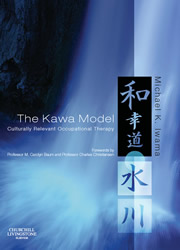There are few publications to date that have critically examined the validity and applicability of Western theoretical models to explain the meaning of occupation and occupational therapy in other cultural contexts. The dearth of original occupational therapy models or attempts to adapt existing conceptual models which have largely been constructed on middle-Western social and cultural norms, may lead many to presume that the concepts and ideas of occupational therapy are universally applicable. Furthermore, many may assume that all occupational therapists and their clients, no matter where they are culturally situated, do not differ much from themselves. That occupational therapy’s core concepts, theory and epistemology remain primarily informed by one particular worldview bounded by social norms and practices germane to Western spheres of experience can render the profession and practice exclusive from a cultural perspective.
Professional Crises; the impetus for a new model of occupational therapy
A group of occupational therapists in Japan pondered this very problem of meaning as they struggled to understand and reconcile the core concepts and principles tying these concepts of occupational therapy to their own lived realities. Without concepts and principles that resonated with their own cultural views of life and wellbeing, these occupational therapists experienced a professional crisis of meaning. When occupational therapists cannot comprehend the meaning of occupation, let alone explain it to their professional peers and clients, they may struggle with professional identity and lack confidence in practice. Another possible consequence is when clients of occupational therapy receive treatment that disadvantages them in the context of their own cultures. Faced with such circumstances and some dissonance between their own values and occupational therapy’s values, some of the Japanese occupational therapists in the group had contemplated leaving the profession. Those remaining in their profession, like their professional peers turned their attention toward a more bio-medically oriented practice where occupational therapy is interpreted and practiced according to a patient’s pathology or disease.
These Japanese therapists came to the realization that contemporary theories about human occupation and occupational performance strongly reflect the modal values, beliefs and social norms of the social contexts they were emerged from. A cursory glance at the structure and concepts of recent conceptual models in the profession reveal a conceptualization of human occupation that is particularly monistic, rational, future oriented and individual-focused. Egalitarian social structure and the ideal of independence are also strongly represented. This can be problematic to people who subscribe to worldview that is more: polytheistic, naturalistic, temporally oriented to the here and now, collectivistic, interdependent, and hierarchical.
The Kawa Model Emerges
In a bold attempt to discover and claim a basic framework for the purpose of describing, explaining and guiding their professional interventions in a culturally appropriate manner, a group of occupational therapists, educators and students in Western Japan embarked on a naturalistic research project that combined heuristic research and grounded theory methodology. With regular monthly meetings (starting in the evening at around 7pm and often extending into the wee hours of the morning, over the course of 2 years, the original prototype of the Kawa model was developed.
While the original purpose of the Kawa model was to describe, explain and guide occupational therapy in Asian social contexts, its use- particularly internationally, has spurned some important revelations. Occupational therapists trying the model in non-Japanese settings, such as Eastern Europe, Australia, the UK and North America have reported that the ‘river’ as a metaphor for life-flow and occupation is relevant to their varied (cultural) practice contexts. Because the Kawa model concepts are ideally named and ascribed meaning by the client, the basic framework of the model as a metaphor to translate subjective states of being in relevant context, is potentially useful in a wide scope of applications. The model is to be altered, modified and shaped by the client and therapist, and not applied as a rigid, universal framework of concepts to which the client’s narratives must be forced.
Another revelation of the model has been its function to broaden and illuminate the fundamental issue of culture to the knowledge (epistemology) and theory of occupation. The narrative of occupation in the Kawa model is one where the individual is de-centered and seen as inseparably imbedded in his or her world. In other words, we would say “the individual is appreciated as being a part of the environment, as much as the environment is a part of the individual”. Changes in the environment or contextual conditions will effect change in the individual, and vice-versa. The Western social imperative of a solitary self on a quest to rationally control a distinctly separate surrounding environment is challenged by the Kawa model narrative.
From these origins, the Kawa model is now transferred to occupational therapists situated in diverse practice contexts, to develop further.
